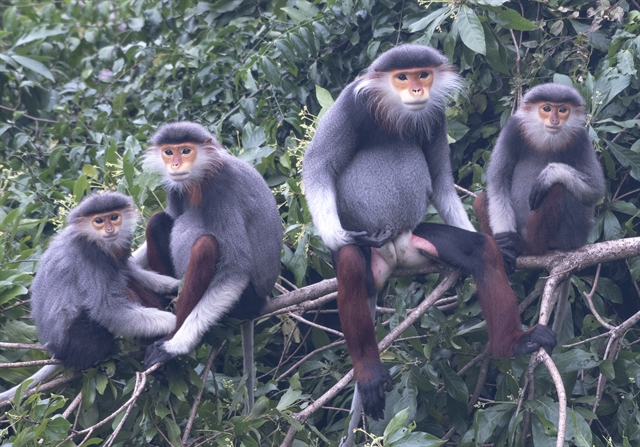 Environment
Environment

The United State Agency for International Development (USAID) Biodiversity Conservation Activity has launched a $1.4 million Species Conservation Fund (SCF) in Việt Nam

|
| A family of red-shanked douc langurs (Pygathrix nemaeus) are taken at Sơn Trà Nature Reserve in Đà Nẵng. The United State Agency for International Development (USAID) Biodiversity Conservation Activity has launched a $1.4 million Species Conservation Fund (SCF) in Việt Nam. Photo courtesy of Bùi Văn Tuấn |
ĐÀ NẴNG – The United State Agency for International Development (USAID) Biodiversity Conservation Activity has launched a $1.4 million Species Conservation Fund (SCF) in Việt Nam to support locally-led conservation efforts initiated by Vietnamese NGOs and other independent organisations.
The launch of the fund was debuted in promoting the World Environment Day with its theme: ‘Only One Earth’, which highlights the importance of conserving biodiversity, including species, across the world. It is especially relevant to the SCF, which aims to support the conservation of myriad wildlife species only found in Việt Nam.
SCF is a part of the $38 million USAID Biodiversity Conservation Activity and aims to strengthen biodiversity conservation in Việt Nam, especially through local organisations. Specifically, the SCF will support local NGOs and research organisations to conduct activities that contribute to conserving priority species of wildlife. The fund will provide awards from $20,000 to $50,000 for projects up to 1.5 years.
“Environmental sustainability is key to sustainable economic growth, and Việt Nam is an important partner of the US Government on global biodiversity conservation. The SCF is a wonderful initiative that will support action at the grassroots level to conserve wildlife, forests, and biodiversity for the future,” said Ann Marie Yastishock, USAID Việt Nam Mission Director.
Việt Nam is one of the world’s most biodiverse countries, but decades of illegal logging, hunting, wildlife trade, and conversion of forests to agricultural lands and infrastructure development have led to staggering losses of natural forest and wildlife, with many species on the edge of extinction.
Many of these species are endemic, and some are iconic, such as Saola (the extremely elusive forest-dwelling bovine only found in the forests of Việt Nam and Laos), Annamite striped rabbit, and several species of turtle. The SCF will focus on supporting conservation and research efforts to ensure endemic and endangered species of wildlife are protected.
USAID Biodiversity Conservation Activity is among the largest joint efforts between the US and Việt Nam Governments on biodiversity conservation. WWF will implement the project in collaboration with the Ministry of Agriculture and Rural Development from 2021 to 2026. The project aims to maintain and increase forest quality, protect and stabilise wildlife populations, and support local livelihoods in high conservation value provinces.
“USAID Biodiversity Conservation project sites include 21 special use and protection forests. We expect that the proposals for SCF will be connected with project activities to increase effectiveness and will strengthen the participation of local organisations in conservation,” said Vũ Văn Hùng, Deputy Director of the Management Board of Forest Projects Ministry of Agriculture and Rural Development.
SCF will start accepting applications from June 2022. It is expected that SCF will strengthen the engagement and coordination among local organisations in species conservation efforts, which is vital to mobilise indigenous knowledge and information on conservation for better evaluation and conservation of wildlife species, as well as strengthening the capacity of local conservation organisations in Việt Nam.
As many as 91 new species were discovered in Việt Nam in 2020, including 85 endemic species, according to the World Wildlife Fund (WWF).
The WWF also warned that primates in the region had declined seriously in recent decades due to human activities such as illegal logging, land-use conversion and grazing. Hunting and trapping also exert huge pressure on the primate population, putting them at risk of extinction. VNS